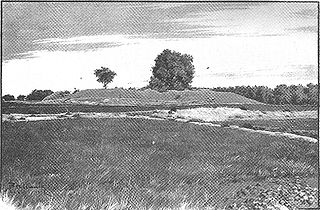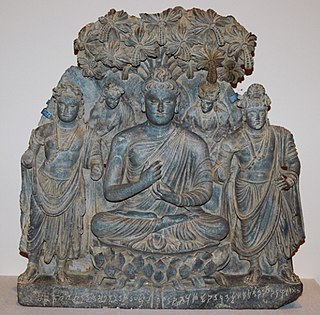
Taxila or Takshashila is a city in the Pothohar region of Punjab, Pakistan. Located in the Taxila Tehsil of Rawalpindi District, it lies approximately 25 kilometres (16 mi) northwest of the Islamabad–Rawalpindi metropolitan area and is just south of the Haripur District of Khyber Pakhtunkhwa.

Kanishka I, Kanishka or Kanishka the Great, was an emperor of the Kushan dynasty, under whose reign the empire reached its zenith. He is famous for his military, political, and spiritual achievements. A descendant of Kujula Kadphises, founder of the Kushan empire, Kanishka came to rule an empire extending from Central Asia and Gandhara to Pataliputra on the Gangetic plain. The main capital of his empire was located at Puruṣapura (Peshawar) in Gandhara, with another major capital at Mathura. Coins of Kanishka were found in Tripuri.
Gandhara, was an ancient Indo-Aryan civilization centered in present-day north-west Pakistan and north-east Afghanistan. The core of the region of Gandhara was the Peshawar and Swat valleys extending as far east as the Pothohar Plateau, though the cultural influence of Greater Gandhara extended westwards into the Kabul valley in Afghanistan, and northwards up to the Karakoram range. The region was a central location for the spread of Buddhism to Central Asia and East Asia with many Chinese Buddhist pilgrims visiting the region.

Sirkap is the name of an archaeological site on the bank opposite to the city of Taxila, Punjab, Pakistan.

Swat District, also known as the Swat Valley, Switzerland of Pakistan, is a district in the Malakand Division of Khyber Pakhtunkhwa, Pakistan. With a population of 2,309,570 per the 2017 national census, Swat is the 15th-largest district of Khyber Pakhtunkhwa with many popular tourist attractions.

The Kanishka casket or Kanishka reliquary, is a Buddhist reliquary made in gilded copper, and dated to the first year of the reign of the Kushan emperor Kanishka, in 127 CE. It is now in the Peshawar Museum in the historic city of Peshawar, Pakistan.

The Bimaran casket or Bimaran reliquary is a small gold reliquary for Buddhist relics that was removed from inside the stupa no.2 at Bimaran, near Jalalabad in eastern Afghanistan.
Chakdara (چکدرہ) is a city in the Lower Dir District of Khyber Pakhtunkhwa, Pakistan. It's the second largest city in Dir Lower after Timergara. It serves as a gateway of Malakand Division. It's located in the center of Malakand Division at the entrance of the Lower Dir District, also near the entrance of the Swat District. The Swat Expressway also touches this area Chakdara interchange. Chakdara is about 130 km far from Peshawar, 40km from Mingora and 38 km from Timergara.

Pushkalavati or Pushkaravati, and later Shaikhan Dheri, was the capital of the ancient region of Gāndhāra, situated in present day's Pakistan. Its ruins are located on the outskirts of the modern city of Charsadda, in Charsadda District, in the Khyber Pakhtunkhwa, 28 kilometres northeast of Peshawar. Its ruins are located on the banks of Swat River, near its junction with Kabul River, with the earliest archaeological remains from 1400 to 800 BCE in Bala Hisar mound. Pushkalavati became an Achaemenid regional capital around 600 BCE, and it remained an important city through to the 2nd century CE.

The Kanishka Stupa was a monumental stupa established by the Kushan king Kanishka during the 2nd century CE in today's Shaji-ki-Dheri on the outskirts of Peshawar, Pakistan.

Buddhism in Pakistan took root in the third century BCE under the Mauryan king Ashoka. The Major Rock Edicts of Ashoka inscribed on rock boulders in Mansehra and Shahbaz Garhi written in the Kharosthi script recording aspects of the emperor's dharma or righteous law represent some of the earliest evidence of deciphered writing in South Asia, dating to middle of the third century BCE. The Indo-Greek king Menander embraced Buddhism as attested in the Milinda Panha, which dates from sometime between 100 BC and 200 AD, following a dialogue with the monk Nāgasena in Sagala, present-day Sialkot.

Jaulian is a ruined Buddhist monastery dating from the 2nd century CE, located in Taxila, in Pakistan.

According to the Mahāparinibbāṇa Sutta, after attaining parinirvana, the body of Buddha was cremated and the ashes divided among his lay followers.

Jandial near the city of Taxila in Pakistan is the site of an ancient temple well known for its Ionic columns. The temple is located 630 meters north of the northern gate of Sirkap. The Temple was excavated in 1912–1913 by the Archaeological Survey of India under John Marshall. It has been called the most Hellenic structure yet found on Pakistani soil.

The Valley of Peshawar, or Peshawar Basin, historically known as the Gandhara Valley, is a broad area situated in the central part of the Khyber Pakhtunkhwa province of Pakistan. The valley is 7,176 km2 (2,771 sq mi) in area, and is traversed by the Kabul River. It has a mean elevation of 345 metres (1,132 ft). The valley takes its name from the city of Peshawar, which is situated at the western part of the valley close to Warsak Dam. To the west of the valley lies the Khyber Pass. The five most populous cities in the valley are Peshawar, Mardan, Swabi, Charsadda, and Nowshera.

Gandhāran Buddhism refers to the Buddhist culture of ancient Gandhāra which was a major center of Buddhism in northwestern Pakistan from the 3rd century BCE to approximately 1200 CE. Ancient Gandhāra corresponds to modern day north Pakistan, mainly the Peshawar valley and Potohar plateau as well as Afghanistan's Jalalabad. The region has yielded the Gandhāran Buddhist texts written in Gāndhārī Prakrit the oldest Buddhist manuscripts yet discovered. Gandhāra was also home to a unique Buddhist artistic and architectural culture which blended elements from Indian, Hellenistic, Roman and Parthian art. Buddhist Gandhāra was also influential as the gateway through which Buddhism spread to Central Asia and China.

Loriyan Tangai is an archaeological site in the Gandhara area of Pakistan, consisting of many stupas and religious buildings where many Buddhist statues were discovered.

Kunala Stupa is a Kushan-era Buddhist stupa and monastery complex to the south-east of Taxila, on a hill about 200 meters just south of Sirkap, Punjab, Pakistan, thought to date to the 2nd century CE. It is located on a hill overlooking the ancient Indo-Greek city of Sirkap.

The Sikri stupa is a work of Buddhist art dated to 3rd-4th century from the Kushan period in Gandahara, consisting of 13 narrative panels with events from the life of Buddha. Modern restoration accounts for their order in the Lahore Museum. The restoration began while Harold Arthur Deane was still assigned to the North-West Frontier Province in what was then British India. Three photos taken around 1890 show the order of the panels in the earliest restoration.

The Brussels Buddha is a famous Buddha statue from the Greco-Buddhist art of Gandhara. It is named after the first collection to which it belonged, the Claude de Marteau collection in Brussels, Belgium, although it is now in a private collection in Japan, belonging to the Agonshū sect of Buddhism. The Brussels Buddha belongs to the category of the "Seated Buddha triads", which can be seen contemporaneously in the Greco-Buddhist art of Gandhara and in the art of Mathura in the early Kushan period. The precise location where the statue was discovered is unknown, but it was acquired in Peshawar, and it is thought to have been excavated in Sahri Bahlol due to its similarity with a statue from the same location, now in the Peshawar Museum.
























